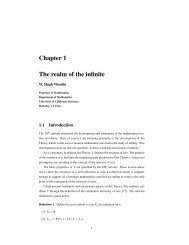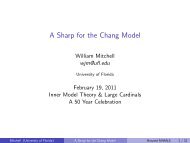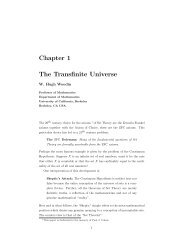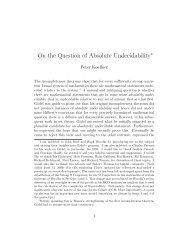SOME SET THEORIES ARE MORE EQUAL ... - Logic at Harvard
SOME SET THEORIES ARE MORE EQUAL ... - Logic at Harvard
SOME SET THEORIES ARE MORE EQUAL ... - Logic at Harvard
You also want an ePaper? Increase the reach of your titles
YUMPU automatically turns print PDFs into web optimized ePapers that Google loves.
4 MENACHEM MAGIDORpossibility ). Now our group theorist when she st<strong>at</strong>es the theorem sheproved she will have to specify, on top of the assumptions about thegroup , the set theoretical universe in which the action takes place. Toa limited extent it is already being done when m<strong>at</strong>hem<strong>at</strong>icians st<strong>at</strong>etheorems by using CH or Martin’s Axiom (MA) but if in the courseof time (like we believe will happen) more set theoretical methods willbe used more and more the exact set theoretical assumptions used willbecome additional burden on m<strong>at</strong>hem<strong>at</strong>ical communic<strong>at</strong>ion.My guess isth<strong>at</strong> the M<strong>at</strong>hem<strong>at</strong>ical community can toler<strong>at</strong>e a limited small numberof set theories but will find it awkward to choose the appropri<strong>at</strong>e settheoretical assumptions from a long list of possible universes or theories.It is up to the Set Theorists to sort out the different possibilities and topick the Set Theory or the small number of set theories which will bemore fruitful or ”truer”. If we continue Hamkins’ analogy to Geometry:the main goal of the set theorists is not exactly like the goal of the puregeometer whose goal is to study all possible geometries but it closer tothe goal of the geometer th<strong>at</strong> together with the physicists try to pickthe geometry which is most appropri<strong>at</strong>e for describing the physicalspace.To some extent the rel<strong>at</strong>ion between the set theorist and the therest of the m<strong>at</strong>hem<strong>at</strong>ical community is like the rel<strong>at</strong>ion between thegeometer and the physicist.The reader of this article may have noticed th<strong>at</strong> I avoided any <strong>at</strong>temptto to argue against pluralism in Set Theory by using ontologicalarguments, like ”realism in ontology” or ”realism in truth values” inthe sense of Shapiro[36].Like many working M<strong>at</strong>hem<strong>at</strong>icians I am basicallya realist of and I do believe in some kind of objective existence ofm<strong>at</strong>hem<strong>at</strong>ical concepts, but I also believe th<strong>at</strong> one can follow a r<strong>at</strong>ionalprocess of finding the favored Set Theory (which for a realist like mewill be the ”correct set theory”) without making any firm ontologicalcommitments. I am symp<strong>at</strong>hetic the argument of Maddy in [25] th<strong>at</strong>by her terminology, the difference between the thin realist and arealistdoes not reflect on the the methodology in which they will analyse thepractice of Set Theory.Of course one can argue, like Feferman in his talk in this series andelsewhere [8],[9] th<strong>at</strong> ”higher” Set Theory is irrelevant to the M<strong>at</strong>hem<strong>at</strong>icalpractice (or the particular choice of axioms) and anyway mostof the M<strong>at</strong>hem<strong>at</strong>ics being done today can be done in some weak constructivesystem. We shall try to deal with this argument in the nextsection .











